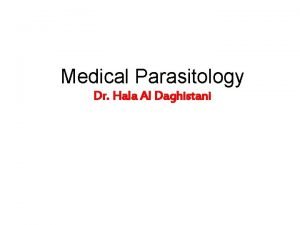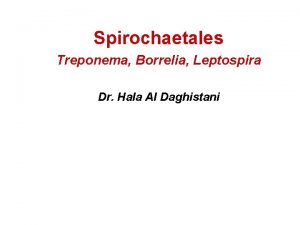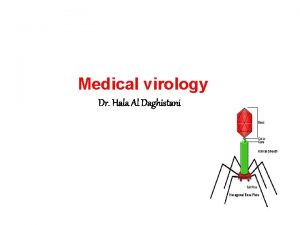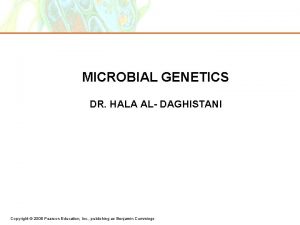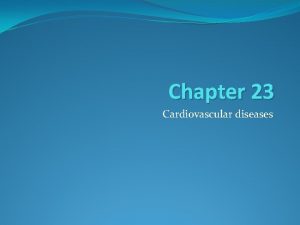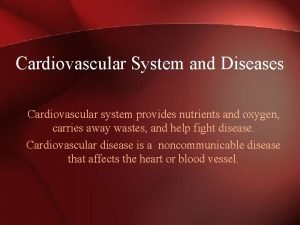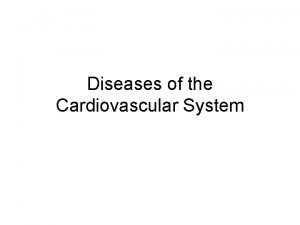Cardiovascular Diseases Dr Hala Al Daghistani Cardiovascular system





































- Slides: 37

Cardiovascular Diseases Dr. Hala Al- Daghistani

Cardiovascular system (circulatory system), defined as a group of organs that transport blood, nutrients, and remove waste products it carries to and from all parts of the body. The cardiovascular (circulatory) system consists of : 1. The heart 2. Blood vessels.

Intracardiac infections: Inflammation of the inner layer of the heart (endocarditis) and veins infection (thrombophlebitis), or arteries (endarteritis) are usually caused by bacteria, although other agents including fungi and viruses have been occasionally implicated. They commonly produce a constant shedding of M. O. into the Bloodstream that is often characterized by continuous, low-grade bacteremia (1 to 20 organisms/ml of blood) in untreated patients.

Disease associated with CVS Endocarditis is characterized by lesions, known as vegetations ﺇﻧﺒﺎﺕ ﻏﻴﺮ ﺳﻮﻱ , (a mass of platelets, fibrin, M. O. colonies , and inflammatory cells) Types of endocarditis: Infective endocarditis -it is simply bacterial endocarditis, because not all infections of the endocardial surface of the heart are caused by bacteria. -Most infections occur on natural or prosthetic cardiac valves, but can also develop on septal defects, or the mural endocardium ﺟﺪﺍﺭ ﺷﻐﺎﻑ ﺍﻟﻘﻠﺐ. The pathogenesis of infective endocarditis involves several factors that result in infection: 1. Alteration of endothelium which facilitate colonization by bacteria and deposition of platelets and fibrin.

2. Transient bacteremia is common, (dental procedures, after normal childbirth and manipulations such as bronchoscopy, cystoscopy ). Even simple activities such as tooth brushing or chewing candy can cause such bacteremia. - The organisms responsible for transient bacteremia are the common surface normal flora such as Viridans streptococci (oropharynx) and are usually of low virulence. - Intravenous drug abuse may lead to transient bacteremia with S. aureus or a variety of Gram-negative aerobic and anaerobic bacteria. Circulating organisms adhere to the damaged surface, followed by complement activation, inflammation, fibrin, and platelet deposition. - M. O. produce sub. that protects them from host humoral, phagocytic immune defenses, some antimicrobial agents.

Growth of M. O. leads to obstruction of blood flow and increased turbulence. Vegetations may break off and be deposited in smaller blood vessels (embolization) with obstruction and secondary sites of infection. Emboli may be transported to the brain or coronary arteries, with disastrous results. The development of circulating immune complexes of microbial antigen and antibody is also important. These complexes can activate complement and contribute to many of the peripheral manifestations , including nephritis, arthritis, and cutaneous vascular lesions.


- There is a widespread stimulus to host cellular and humoral immunity, particularly if the infection continues for more than about 2 weeks. This condition is characterized by 1. Hyperglobulinemia 2. Splenomegaly 3. Appearance of MQs in the peripheral blood. - Some patients develop circulating rheumatoid factor (Ig. M directed towards modified Ig. G ), which may play a deleterious role by blocking Ig. G opsonic activity and causing microvascular damage. - ANA, which also appear, may contribute to fever, arthralgia, and myalgia. In conclusion: Infective endocarditis involves an initial complex of endothelial damage or abnormality, which facilitates colonization, with local and systemic inflammatory, embolic, and immunologic complications.


Why the valve is affected? * The valves of the heart do not receive any dedicated blood supply. As a result, defensive immune system mechanisms (such as WBCs) cannot directly reach the valves via the bloodstream. * If an organism (such as bacteria) attaches to a valve surface and forms a vegetation, the host's immune response is blunted. * The lack of blood supply to the valves also has implications for treatment, since drugs also have difficulty reaching the infected area. Normally, blood flows smoothly through these valves. If they have been damaged the risk of bacterial attachment is increased

Infective endocarditis has often been classified to: Acute endocarditis (AE) is generally fulminant with high fever and toxicity, and death may occur in a few days or weeks. Subacute endocarditis (SAE)progresses to death over weeks to months with low-grade fever, night sweats, weight loss, and vague constitutional complaints. The infecting organism ** S. aureus, produces acute disease ** Viridans Streptococci are more likely to be subacute. - Physical findings: changing heart murmur, splenomegaly, various skin lesions (petechiae, hemorrhages, Osler’s nodes, Janeway’s lesions), and retinal lesions. Other complications relate to the immunologic and embolic phenomena: kidney damage, and hematuria. Renal failure, presumably from (IC ) glomerulonephritis.

red-purple, slightly raised, associated with SAE , often with a pale centre non-tender lesion, often haemorrhagic (bleeding into the skin), and associated with AE Osler's nodes and Janeway lesions are skin manifestations of bacterial endocarditis. Osler's nodes are of immunologic origin.

Common Etiologic Agents in Infective Endocarditis AGENT PERCENTAGE OF CASES Viridans Streptococci 30– 40 Enterococci 5– 18 Other Streptococci 15– 25 Staphylococcus aureus 15– 40 Coagulase-negative Staphylococci 4– 30 Gram-negative Bacilli (HACEK group) 2– 13 Pseudomonas aeruginosa Fungi (e. g, Candida, Aspergillus) Streptococci are most common cause 2– 4

HACEK group - Haemophilus aphrophilus, - Aggregatibacter (Actinobacillus ) - Cardiobacterium hominis, - Eikenella corrodens - Kingella kingae.

In the culture-negative group, infective endocarditis is diagnosed on clinical grounds. Negative cultures may result from (1) prior antibiotic treatment (2) fungal endocarditis with entrapment of these relatively large organisms in capillary beds (3) fastidious, nutritionally deficient, or cell wall–deficient organisms that are difficult to isolate (4) infection caused by obligate intracellular parasites, such as chlamydiae (Chlamydia psittaci), rickettsiae (Coxiella burnetii), or viruses. (5) immunologic factors (eg, antibody acting on circulating organisms). Etiologic Agents More Commonly Observed in Special Circumstances ** Intravenous drug abuse : Staphylococcus aureus; Enterococci; Enterobacteriaceae and Pseudomonas; Fungi ** Prosthetic valve infection : Coagulase-negative Staphylococcus; S. aureus; Enterobacteriaceae and Pseudomonas; Diphtheroids; Candida and Aspergillus spp. In immunocompromise and chronic illness, any of the above organisms might present

Libman–Sacks endocarditis : - Is a form of Nonbacterial endocarditis that is seen in association with systemic lupus erythematosus. - It is one of the most common heart-related manifestations of lupus. The condition mostly involves the mitral and aortic valves - The vegetations are small and formed from strands of fibrin, neutrophils, lymphocytes, and histiocytes. - Libman-Sacks lesions rarely produce significant valve dysfunction and the lesions only rarely embolize. However, the mitral valve is typically affected, and the vegetations occur on the ventricular and atrial surface of the valve, or some times being as pericarditis (inflammation of the fibrous sac surrounding the heart)

General Diagnostic Approaches in cases with infective endocarditis - Diagnosis of IE is suspected on clinical grounds - Most important diagnostic test is the blood culture. - Untreated cases, the M. Os are generally present continuously in low numbers (1 to 20/m. L) in the blood. - Most authorities recommend three cultures over 24 hours to ensure detection. - Multiple cultures yielding the same organism support the probability of an intravascular or intracardiac infection. - Bactericidal antimicrobics required. - Antimicrobial prophylaxis indicated for those with cardiac abnormalities

Rheumatic fever An inflammatory systemic disease that can involve the heart, joints, skin, CNS, and brain. The heart is involved in about half of cases. Rheumatic fever occur following an infection of the throat by the bacterium Streptococcus pyogenes (GAS) - It is believed to be caused by antibody cross-reactivity. Abs are produce against the cell wall of Streptococcus. However due to molecular mimicry the antibodies may react with the myocardium producing the symptoms of rheumatic fever. - S. pyogenes has a cell wall composed of M protein that are antigenic. The Abs which are generates against the M protein may cross-react with heart muscle cell protein myosin, heart muscle glycogen and smooth muscle cells of arteries, inducing cytokine release and tissue destruction. - Symptoms include : joint pain and swelling (arthritis) and inflammation of the heart, which can cause shortness of breath and chest pain.



Intravenous Catheter Bacteremia A variant of intravascular infection develops when intravenous catheter or any of several types of monitoring devices placed in the bloodstream becomes colonized with microorganisms. The organisms involved are usually those found in the skin flora, such as: S. epidermidis, Corynebacterium jeikeium, or S. aureus. In debilitated patients already on antimicrobial therapy, Candida species may be involved. Occasionally, the sources of contamination are the intravenous solutions themselves rather than the skin. In these cases, members of the Enterobacteriaceae, Pseudomonas, or other Gram-negative rods are more likely.


BACTEREMIA FROM EXTRAVASCULAR INFECTION Most cases of clinically significant bacteremia are the result of an extravascular infection. In these cases, the organisms escaping from the infected focus reach the capillary and venous circulation through the lymphatic vessels. - Any organism producing meningitis is likely to produce bacteremia at the same time. Infections with H. influenzae type b are usually bacteremic, whether the site is the meninges, epiglottis, or periorbital tissues. The most common sources of bacteremia are 1. UTIs 2. RTIs 3. infections of skin or soft tissues, such as wound infections or cellulites.

Frequency of Detection of Bloodstream Invasion by Bacteria and Some Fungi during Significant Infections at Extravascular Sites LARGE (90%) PROPORTION OF CASES Haemophilus influenzae type b Brucella Neisseria meningitidis Salmonella typhi Streptococcus pneumoniae Listeria VARIABLE (10– 90%) DEPENDING ON STAGE AND SEVERITY OF INFECTION Beta-hemolytic streptococci Enterobacteriaceae S. pneumoniae Pseudomonas Staphylococcus aureus Bacteroides Neisseria gonorrhoeae Clostridium (myositis and endometritis) Leptospira, Borrelia Anaerobic cocci Candida, Cryptococcus neoformansa Acinetobacter Shigella dysenteriae

SMALL (10%) PROPORTION OF CASES Shigella (except S. dysenteriae) Pasteurella multocida Salmonella enteritidis Haemophilus, nonencapsulated Campylobacter jejunia ISOLATION TOO RARE Vibrio (intestinal infections) Clostridium tetani Corynebacterium diphtheriae Clostridium botulinum Bordetella pertussis Clostridium difficile Mycobacterium Legionellac

Bacteremia is the presence of viable bacteria circulating in the blood *Presence of organisms not permanent. *Organisms not multiplying. *Patient asymptomatic. Both Gram- negative and Gram-positive organisms , as well as fungi, protozoa, and even some viruses. Causes of Bacteraemia Group B streptococcus , Streptococcus pneumoniae Escherichia coli (and other enteric Gram negative bacilli) Listeria monocytogenes Haemophilus influenzae Staphylococcus aureus Neisseria meningitides Salmonella spp

Septicaemia: is a potentially life-threatening infection in which large amounts of multiplying bacteria are present in the blood. Patient acutely symptomatic. Sepsis is the Widespread Inflammation in the body. It is caused by an immune response triggered by an infection. Infection triggers a serious body response , which typically includes fever, weakness, and an increased number of WBCs…. . . If the sepsis remains uncontrolled, there is subsequent progression to Septic shock (development of hypotension) Refractory septic shock (hypotension not responsive to standard fluid and pharmacologic treatment) and multiorgan failure, including major target organs

Bacteremia Septicemia Bacteremia is the simple presence of bacteria in the blood. Bacteremia is not as dangerous as Septicemia. Less amount of bacteria are present in blood. This may occur through a wound or infection, or through a surgical procedure or injection. Toxins are not produced. Bacteremia usually causes no symptoms or it may produce mild fever. It can resolve without treatment. Septicemia is the presence and multiplication of bacteria in the blood. Septicemia is a potentially life-threatening infection. Rapidly removed from the bloodstream by the immune system Caused by Staphylococcus, Streptococcus, Pseudomonas, Haemophilus, E. coli, herpes, Clostridium difficile . Antibiotics will be used to treat the bacterial infection that is causing septicemia. Staphylococci, are thought to cause more than 50% of cases of sepsis. Other bacteria include Streptococcus pyogenes, Escherichia coli, Pseudomonas aeruginosa, Klebsiella species and even Candida spp. Large amounts of bacteria are present in the blood. It can arise from infections throughout the body, including infections in the lungs, abdomen, and urinary tract. Toxins may be produced by bacteria. It shows symptoms like chills, fever, prostration, very fast respiration and/or heart rate. Untreated septicemia can quickly progress to sepsis.

The mechanisms involved in development of septic shock can be produced with the LPS endotoxin of the Gram-negative cell wall. They include : (1) release of vasoactive substances such as histamine, serotonin, noradrenaline, and plasma kinins, which may cause arterial hypotension directly and facilitate coagulation abnormalities resulting in disseminated intravascular coagulation (DIC). (2) disturbances in temperature regulation, mediated by interleukin 1 (IL-1) and tumor necrosis factor (TNF) released from macrophages (3) complement activation and release of other inflammatory cytokines by macrophages (eg, IL-2, IL-6, IL-8, and interferon-gamma) (4) direct effects on vascular endothelial cell function and integrity (5) depression of cardiac muscle contractility by TNF, myocardial depressant factor, and other less well-defined serum factors

BLOOD CULTURE A sample of the patient’s blood is obtained by aseptic venipuncture and cultured in an enriched broth or, after special processing, on plates. - Growth is detected, and the organisms are isolated, identified, and tested for antimicrobial susceptibility Venipuncture Before venipuncture, the skin over the vein must be carefully disinfected to reduce the probability of contamination of the blood sample with skin bacteria(A combination of 70% alcohol and an iodine-based antiseptic). - Blood is drawn directly into a blood culture bottle or a sterile blood collection vacuum tube containing an anticoagulant free of antimicrobial properties. - Sodium polyanethol sulfonate is preferred; other anticoagulants such as citrate and ethylene diamine tetra acetic acid (EDTA) have antibacterial activity. -

Volume 1. Younger than 10 years …. 1 m. L of blood for each year of life 2. 10 years or older ……… 20 m. L - In intravascular infections (eg, infective endocarditis), a single blood culture is positive in more than 95% of cases. - Studies of sequential blood cultures from bacteremic patients without endocarditis have yielded 80 to 90% positive results on the first culture, more than 90 to 95% with two cultures, and 99% in at least one of a series of three cultures. - 2 -3 sets with 30 to 60 minutes in between draws


organisms are cleared before the appearance of any clinical findings suggesting sepsis. - The continuous bacteremia of infective endocarditis is usually readily detected, and timing is not critical. - Intermittent bacteremia presents the greatest challenge because fever spikes generally occur after, rather than during, the bacteremia. - It is generally not useful to collect blood cultures while the patient is receiving antimicrobics. The laboratory should be advised when such cultures are submitted, because it is sometimes possible to inactivate an antimicrobic, for example, with beta-lactamases, Antibiotic removal device (ARD).

Daily examination of cultures for 1 week or more and a routine schedule of stains and/or subcultures of apparently negative cultures are required to detect organisms such as H. influenzae or N. meningitidis, which usually do not produce visual changes in the broth. Continuous-Monitoring Blood Culture Systems Bac. T/ALERT 3 D System This is an closed system and works on the colorimetric principle of detection of CO 2 produced by the organisms. The CO 2 causes a lowering in the p. H of the medium, which in turn produces a colour change in a sensor attached to the CO 2 sensitive base of each bottle. • Fungemia and mycobacteria use of lysis centrifugation system (Isolator tube contains a mixture of saponin, propylene glycol, SPS, and EDTA). -This mixture causes lysis of white and red blood cells, releasing intracellular organisms; prevents clotting; and neutralizes complement. • Viremia ( used Serology or molecular-based detection systems)

Criteria of differentiation True pathogen versus Normal microbiota Number of BC sets Type of MO isolated Criteria Identify of the microorganism. S. aureus, E. coli and other members of the Enterobacteriaceae, S. pneumoniae, P. aeruginosa, and Candida albicans when isolated almost always indicate true infection, whereas Co. NS, diphtheroids, and other skin folra when isolated should be questioned. More than one blood culture bottle growing the same organism usually indicates that the isolate is significant, whereas growth of an organism, especially one associated with skin flora, in a single bottle when multiple bottles are inoculated usually indicates that the isolate is a contaminant. Isolation of the same organism in the blood and from a normally sterile site usually indicates that the organism isolated from the blood is a pathogen

Continuous-Monitoring Blood Culture Systems

 Hala hala rizal
Hala hala rizal Cardiovascular system diseases and disorders chapter 8
Cardiovascular system diseases and disorders chapter 8 Dr al daghistani
Dr al daghistani Dr al daghistani
Dr al daghistani Swarming proteus
Swarming proteus Dr daghistani
Dr daghistani Amcamızın eşine ne denir
Amcamızın eşine ne denir Solutii finantare imm
Solutii finantare imm 3 hala tuju kpm
3 hala tuju kpm Hala sportowa czerniejewo
Hala sportowa czerniejewo Contoh komunikasi dalam organisasi
Contoh komunikasi dalam organisasi Sham country map
Sham country map Botten på göl
Botten på göl Pusat bertauliah jpk
Pusat bertauliah jpk Halatuju organisasi
Halatuju organisasi Cengiz yaman
Cengiz yaman Ppd kota kinabalu
Ppd kota kinabalu Contoh pmi ts25
Contoh pmi ts25 Hala ere lokailua
Hala ere lokailua Bahan ts25
Bahan ts25 Consaguinity
Consaguinity Chapter 6 musculoskeletal system
Chapter 6 musculoskeletal system Chapter 17 reproductive system diseases and disorders
Chapter 17 reproductive system diseases and disorders Chapter 15 nervous system diseases and disorders
Chapter 15 nervous system diseases and disorders Chapter 10 lymphatic system diseases and disorders
Chapter 10 lymphatic system diseases and disorders Sphyx medical term
Sphyx medical term Diseases of the musculoskeletal system
Diseases of the musculoskeletal system Sperm fructose
Sperm fructose Capillary bed
Capillary bed What makes up the circulatory system
What makes up the circulatory system Pithed model
Pithed model Its tubular dude
Its tubular dude Com
Com Cengage chapter 5
Cengage chapter 5 Figure 11-9 is a diagram of the hepatic portal circulation
Figure 11-9 is a diagram of the hepatic portal circulation Figure 11-2 is an anterior view of the heart
Figure 11-2 is an anterior view of the heart Lesson 11 cardiovascular system
Lesson 11 cardiovascular system Lesson 11 cardiovascular system
Lesson 11 cardiovascular system



